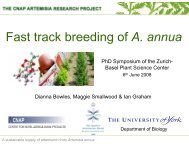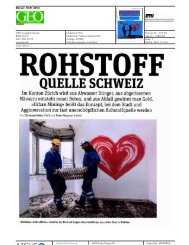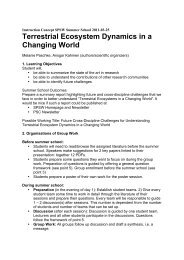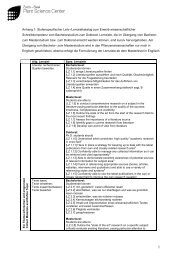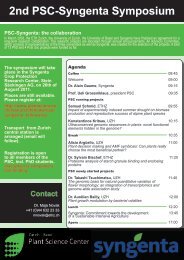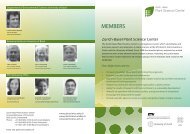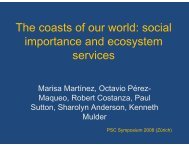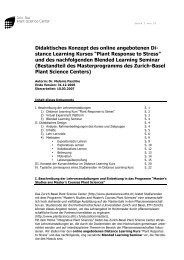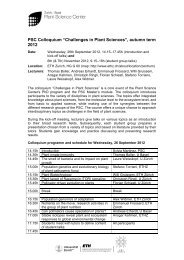Pathogen phytosensing: plants to report plant pathogens
Pathogen phytosensing: plants to report plant pathogens
Pathogen phytosensing: plants to report plant pathogens
Create successful ePaper yourself
Turn your PDF publications into a flip-book with our unique Google optimized e-Paper software.
<strong>Pathogen</strong> <strong>phy<strong>to</strong>sensing</strong>: <strong><strong>plant</strong>s</strong> <strong>to</strong> <strong>report</strong> <strong>plant</strong> <strong>pathogens</strong><br />
C. Neal Stewart, Jr<br />
Department of Plant Sciences<br />
University of Tennessee<br />
Knoxville, TN, USA<br />
PSC Symposium 2008, Zurich, Switzerland
Phy<strong>to</strong>sensor components<br />
• Basic biology of what needs sensing; e.g.,<br />
<strong>plant</strong>-pathogen pathogen interactions<br />
• Engineered signal transduction pathway<br />
• Transgenic <strong>plant</strong> system<br />
• Output signal<br />
• Detection of output signal
Why Phy<strong>to</strong>sensors?<br />
• Wide area detection– standoff<br />
• Detection of events<br />
• Sensing abiotic or biotic fac<strong>to</strong>rs<br />
• Chemicals<br />
• Explosives<br />
• Plant <strong>pathogens</strong><br />
• Pollutants<br />
• Bio agents?
GFP as an induced output signal
Induced GFP phy<strong>to</strong>sensors<br />
induction<br />
No pathogen<br />
+pathogen<br />
Using inducible<br />
promoter/GFP<br />
fusions
Causes of Plant Diseases<br />
(biotic fac<strong>to</strong>rs)<br />
Fungi Bacteria Viruses Nema<strong>to</strong>des<br />
Soybean<br />
Asian rust<br />
Soybean<br />
bacterial blight<br />
Soybean<br />
mosaic virus<br />
Soybean<br />
cyst nema<strong>to</strong>de
Regulation of defense gene expression by <strong>plant</strong> signal molecules<br />
Aggressors<br />
fungi, bacteria, viruses, nema<strong>to</strong>des<br />
Depending on the nature of a particular<br />
aggressor the <strong>plant</strong> is able <strong>to</strong> fine-tune the<br />
induction of defense genes by employing<br />
signal molecules jasmonic acid (JA), salicylic<br />
acid (SA), and ethylene (C 2 H 4 ).
Plant defense responses and phy<strong>to</strong>sensors<br />
• Inducible <strong>plant</strong> defense is controlled by:<br />
- Signal transduction pathways<br />
- Inducible promoters<br />
- Cis-regula<strong>to</strong>ry elements corresponding <strong>to</strong> key genes involved in defense<br />
- <strong>Pathogen</strong>-specific responses<br />
• Identified inducible promoters and cis-acting elements could<br />
be utilized in <strong>plant</strong> sentinels, or “phy<strong>to</strong>sensors”, by fusing these<br />
<strong>to</strong> <strong>report</strong>er genes <strong>to</strong> produce <strong><strong>plant</strong>s</strong> with altered phenotypes in<br />
response <strong>to</strong> the presence of <strong>pathogens</strong>.
Early detection of <strong>plant</strong> diseases<br />
Functional analysis of GN-1 promoter<br />
(Alonso et al., 1995 Plant J 7(2) 309-320)<br />
-139 : GGCGGC<br />
consensus sequence in<br />
promoters from PR<br />
protein families<br />
-2000 -736 -278 -130 -1<br />
region with<br />
positive<br />
regula<strong>to</strong>ry<br />
sequence AND<br />
high inducibility<br />
(up <strong>to</strong> 18 fold<br />
induction)<br />
negative<br />
regula<strong>to</strong>ry<br />
sequences<br />
minimal<br />
inducible<br />
promoter (1.7<br />
fold induction)
Inducible expression<br />
Kooshki et al. 2003 Plant Sci 165:213-219
Disadvantages of using a full length promoters of pathogen inducible genes<br />
Arabidopsis PR-1 promoter<br />
gtttataccgattaaaaaaataataatgcttagttataaattactatttattcatgctaaactatttctcgtaactattaaCCAATag<br />
taattcatcaaattttaaaattctcaattaattgattcttgaaattcataaccttttaatattgattgataaaaatatacataaactcaatc<br />
tttttaatacaaaaaaactttaaaaaatcaatttttctGattcggagggagtatatgttattgcttagaatcacagattcatatcaggat<br />
tggaaaattttaaagccagtgcatatcagtagtcaaaattggtaaatgatatacgaaggcggtacaaaattaggtatactgaaga<br />
TAGAAgaacacaaaagtagatCGGTcacctagagtttttcaatttaaactgcgtattagtgtttggaaaaaaaaaacaaagtg<br />
tatacaatgtcaatcggtgatctttttttttttttttttttttttttttctttttggataaatctcaatgggtgatctattgactgtttctctACGTcac<br />
tattttacttACGTCAtagatgtGGCGGCatatattcttcaGGACTTTTCagccataggcaagagtgatagagatactc<br />
atatgcatgaaacactaagaaacaaataattcttgactttttttcttttatttgaaaattgactgtagatataaacttttattttttctgac<br />
tgtaaatataatcttaattgccaaactgtccgatacgAtttttctgtattatttacaggaagatatcttcaaaacattttgaatgaagtaatat<br />
atgaaattcaaatttgaaatagaagacttaaattagaatcatgaagaaaaaaaAaacacaaaaCAACtgaatgacatgaaaca<br />
actatatacaatgtttcttaataaacttcatttagggtatacttacatatatactaaaaaaatatatcaacaatggcaaagctaccgatac<br />
gaaacaatattaggaaaaatgtgtgtaaggacaagattgacaaaaaaatagttacgaaaacaacttctattcatttggacaattgca<br />
atgaatattactaaaatactcaCACATGgaccatgtatttacaaaaACGTgagatctatagttaacaaaaaaaaaaagaaaaaa<br />
atagttttcaaatctctatataagcgatgtttacgaaccccaaaatcataacacaacaataaccattatcaacttagaaaaATG<br />
CCAAT – HSE- heat shock element<br />
TAGAAgaaca – TSE-SA-responsive element<br />
CGGTca & CAACtg – MYB-binding drought inducible elements<br />
CACATG – water stress inducible element<br />
tctACGTcac & aACGTg – ABRE-ABA responsive elements<br />
ACGTCA – bZIP (W-like-box)<br />
GGCGGC – ethylene responsive element<br />
GGACTTTTC – NF-kB-like element
Cis-acting elements responsive <strong>to</strong> defense signal molecules and/or<br />
<strong>pathogens</strong><br />
Cis-acting element Core sequence Gene promoter<br />
GCC-like elements:<br />
GCC-box-ethylene responsive AGCCGCC Tobacco PR-genes: basic chitinase,<br />
element (ERE) - binding site<br />
b-1,3-glucanase<br />
for EREBPs<br />
EREBPs<br />
S-element GCC-like box AGCCACC Parsley ELI7 - elici<strong>to</strong>r-inducible<br />
(binding fac<strong>to</strong>r unknown)<br />
JA-responsive elements<br />
JAR CAAT-like box: GCCAAAT Arabidodpsis VSP1 - Vegetative<br />
G-like boxes: CACGCC<br />
s<strong>to</strong>rage protein<br />
AACGTG<br />
JERE - JA and elici<strong>to</strong>r responsive GCC-like box AGACCGCC Periwinkle Str - Stric<strong>to</strong>sidine<br />
element - binding site for ORCA-2<br />
synthase<br />
W-like boxes-binding site for<br />
WRKY transcription fac<strong>to</strong>rs<br />
W1-box TTGACC Pasley PR1<br />
NPR-1-motif 2W1-boxes TTGACTTGAC Arabidodpsis NPR1<br />
W2-box GTCAA<br />
JASE1-JA-responsive element CGTCAATGAA Arabidopsis OPR1 - 12-oxo-phy<strong>to</strong>-<br />
JASE2-JA-responsive element CATACGTCGTCAA dienoic acid-10,11-reductase<br />
SARE -SA-responsive element TTCGACCTCC Tobacco PR2-d<br />
(binding fac<strong>to</strong>r -unknown)<br />
Gst 1 box GCC-like box AGCCACC Pota<strong>to</strong> GST1 - glutatione<br />
W1-box TTGACC<br />
s-transferase<br />
PR-1-motif bZip(W2-box) ACGTCA Arabidopsis PR-1<br />
NF-kB-like box GGACTTTTC<br />
GCC- box GGCGGC<br />
as-1 - binding site for ASF-1 CTGACGTAAGGGATGACGCAC CaMV 35S promoter, PR genes
Synthetic promoter-GUS fusion constructs<br />
RE RE RE RE min 35S GUS NosT<br />
XbaI<br />
SpeI<br />
Each regula<strong>to</strong>ry element (RE) was synthesized with restriction sites for<br />
XbaI at the 5' end and SpeI at the 3' end. Synthetic promoters as<br />
tetramers of certain RE were placed upstream of 35S minimal promoter<br />
(min 35S containing the TATA box).<br />
This vec<strong>to</strong>r was constructed for<br />
GUS <strong>report</strong>er expression with the<br />
ability <strong>to</strong> swap GUS for fluorescent<br />
protein (FP) <strong>report</strong>ers for use in a<br />
fluorescent <strong>phy<strong>to</strong>sensing</strong> system.<br />
RFP<br />
GFP
Testing synthetic promoters in Arabidopsis pro<strong>to</strong>plasts<br />
(response <strong>to</strong> <strong>plant</strong> defense elici<strong>to</strong>r chitin)<br />
GUS activity (pmol MU/min*mg<br />
protein)<br />
2500<br />
2000<br />
1500<br />
1000<br />
500<br />
0<br />
-46 35S<br />
control<br />
300ug/mlChitin<br />
1.3 3.3 5.6 2.5 2 1.3<br />
4xPR1<br />
4xJAR<br />
4xGst1<br />
4xSARE<br />
4xERE<br />
4xS<br />
(fold)<br />
5.5<br />
0.64 2.1 2.2 6.7<br />
2xas-1<br />
2xNPR1<br />
2xJERE<br />
2xJASE1
Testing synthetic promoters in Arabidopsis pro<strong>to</strong>plasts (response <strong>to</strong> defense<br />
signal molecules)<br />
G US activity (p m o lM U /m in * m g p ro tein )<br />
10000<br />
9000<br />
8000<br />
7000<br />
6000<br />
5000<br />
4000<br />
3000<br />
2000<br />
1000<br />
0<br />
(fold)<br />
1.2<br />
control<br />
0,5mM SA<br />
1.36 21 14.5 14.2 9 1.3 2.7<br />
35S -46 35S 4xPR1 4xGst1 4xSARE 4xS 2xas-1 2xNPR1<br />
GUS activity (p m o lM U /m in *m g p ro tein )<br />
900<br />
800<br />
700<br />
600<br />
500<br />
400<br />
300<br />
200<br />
100<br />
0<br />
control<br />
10uM MeJA or 1mM<br />
ethephon<br />
0.87 2.2 1.1 1.76<br />
(fold)<br />
5.6<br />
-46 35S 4xJAR 2xJERE 2xJASE1 4xERE
Multiplication of core sequence and combination of motifs with different<br />
specificity <strong>to</strong> treatments<br />
4500<br />
4000<br />
3500<br />
3000<br />
2500<br />
2000<br />
1500<br />
1000<br />
500<br />
0<br />
control<br />
30ug/mlChitin<br />
0,5mM SA<br />
2xPR1<br />
4xPR1<br />
2xW2/2xPR1<br />
2xW2<br />
2xJASE2/2xW2<br />
2xJASE2<br />
4xW2/2xS<br />
GUS activity (pmolMU/min*mg protein)
Enhanced synthetic promoters<br />
To increase basal level of the GUS expression, synthetic promoters<br />
rs<br />
were supplemented with the addition of enhancer elements from the<br />
CaMV 35S promoter.<br />
Domains of the CaMV 35S promoter<br />
B<br />
B1<br />
B2<br />
B3 B4 B5 A1 min35S<br />
A<br />
-343 -301 -208 -155 -108 -90 -46 +8<br />
Enhanced synthetic promoters<br />
Version 1<br />
B3-A1 (-208-46)<br />
4 x RE<br />
min35S<br />
Marker Gene<br />
Version 2<br />
B (-343-90)<br />
4 x RE<br />
A1<br />
min35S<br />
Marker Gene
Examining synthetic promoters in transgenic <strong>to</strong>bacco <strong><strong>plant</strong>s</strong><br />
His<strong>to</strong>chemical analysis of<br />
GUS expression<br />
Fluorometric analysis of<br />
GUS expression
Examining synthetic promoters in transgenic Arabidopsis<br />
<strong><strong>plant</strong>s</strong><br />
His<strong>to</strong>chemical analysis of<br />
GUS expression<br />
Fluorometric analysis of<br />
GUS expression
Examining synthetic promoters in response <strong>to</strong> virus infection<br />
Fluorometric analysis of GUS expression in transgenic <strong>to</strong>bacco <strong><strong>plant</strong>s</strong><br />
infected with Alfalfa mosaic virus (AMV). Each value represents the<br />
mean of three inoculated <strong><strong>plant</strong>s</strong> ± standard error.
In <strong>plant</strong>a fluorescence<br />
Relative fluorescence<br />
λ ex = 395 nm<br />
Wavelength (nm)
Spectrofluorometer vs. GFProbe<br />
1800<br />
r 2 = 0.797<br />
1500<br />
1200<br />
900<br />
600<br />
Canola<br />
Growth<br />
Chamber<br />
300<br />
1800<br />
r 2 = 0.896<br />
GFProbe (fluorescence)<br />
1500<br />
1200<br />
900<br />
600<br />
Tobacco<br />
Greenhouse<br />
300<br />
1800<br />
r 2 = 0.872<br />
1500<br />
1200<br />
900<br />
Tobacco<br />
Field<br />
600<br />
300
LIFI
Canola LIFS<br />
200000<br />
180000<br />
160000<br />
140000<br />
Water Raman Peak<br />
A1<br />
A2<br />
A3<br />
Intensity<br />
120000<br />
100000<br />
80000<br />
60000<br />
40000<br />
20000<br />
0<br />
400 450 500 550 600 650 700 750 800<br />
Nanometers (nm)<br />
A4<br />
A5<br />
A6<br />
A7<br />
A8<br />
A9
With<br />
GFP<br />
CPS<br />
400000<br />
350000<br />
300000<br />
250000<br />
200000<br />
150000<br />
Brassica napus leaf fluorescence<br />
Why<br />
RFP is<br />
better<br />
100000<br />
50000<br />
0<br />
425<br />
438<br />
451<br />
464<br />
477<br />
490<br />
503<br />
516<br />
529<br />
542<br />
555<br />
568<br />
581<br />
594<br />
607<br />
620<br />
633<br />
Wavelength<br />
375 nm excitation 425 nm excitation 475 nm excitation<br />
525 nm excitation 550 nm excitation GFP 375 nm excitation<br />
646<br />
Nicotiana tabacum leaf fluorescence<br />
400000<br />
350000<br />
300000<br />
250000<br />
CPS<br />
200000<br />
150000<br />
100000<br />
50000<br />
0<br />
425<br />
438<br />
451<br />
464<br />
477<br />
490<br />
503<br />
516<br />
529<br />
542<br />
555<br />
568<br />
581<br />
594<br />
607<br />
620<br />
633<br />
646
Summary<br />
• Cis-acting elements from promoter regions are defined from<br />
phy<strong>to</strong>hormones for general pathogen sensing.<br />
• Synthetic promoters were constructed by combining various regula<strong>to</strong>ry<br />
elements supplemented with the enhancer elements from the CaMV 35S<br />
promoter <strong>to</strong> increase basal level of the GUS expression.<br />
• The inducibility of each synthetic promoter was first assessed in transient<br />
expression assays using Arabidopsis pro<strong>to</strong>plasts and then examined for<br />
efficacy in stably transgenic Arabidopsis and <strong>to</strong>bacco <strong><strong>plant</strong>s</strong>.<br />
•Transgenic <strong>to</strong>bacco <strong><strong>plant</strong>s</strong> infected with Alfalfa mosaic virus showed an<br />
increase in GUS expression when compared <strong>to</strong> mock-inoculated control<br />
<strong><strong>plant</strong>s</strong>.<br />
•May still need <strong>to</strong> amplify the output signal for detection.
Site-specific<br />
recombinase-mediated<br />
mediated transgene<br />
excision<br />
loxP<br />
Cre<br />
Transgene<br />
loxP<br />
loxP<br />
Cre Transgene loxP<br />
loxP
Model <strong>phy<strong>to</strong>sensing</strong> construct—heat<br />
shock promoter<br />
FRT<br />
GFP<br />
FLP<br />
OCS<br />
NOS<br />
LOX<br />
Stls1<br />
LB<br />
FLP<br />
tetA<br />
HSP<br />
T35S<br />
trfA<br />
NptII<br />
FRT<br />
35S<br />
LOX<br />
CaMV PolyA<br />
hygromycin resistance<br />
CaMV35Sp<br />
pBIN-HSP-FLP-GFP-Hyg<br />
15971 bp<br />
NPTIII<br />
IS1<br />
NPT III<br />
kilA<br />
RB<br />
ori V<br />
tetA<br />
traF<br />
ColE1
Transient agroinfiltration studies<br />
250<br />
GFP (counts per second)<br />
200<br />
150<br />
100<br />
50<br />
Uninduce<br />
d<br />
37C<br />
0<br />
GV-3850 pBI-HSP-GFP pBIN-HSP-FLP-GFP-Hyg<br />
Constructs
UNINDUCED 37C 42C<br />
GV-3850<br />
pBI-HSP-GFP<br />
pBIN-HSP-FLP-GFP<br />
pBIN-mgfp5ER
John DiBenedetti<br />
Kevin Kyle<br />
Hani Al-Ahmad<br />
Irina Teplova<br />
Matt Halfhll<br />
Tzfi Tzfira<br />
David Ow<br />
Mitra Kooshki<br />
Reza Haijimorad





